Toyota Auris Touring Sports Hybrid
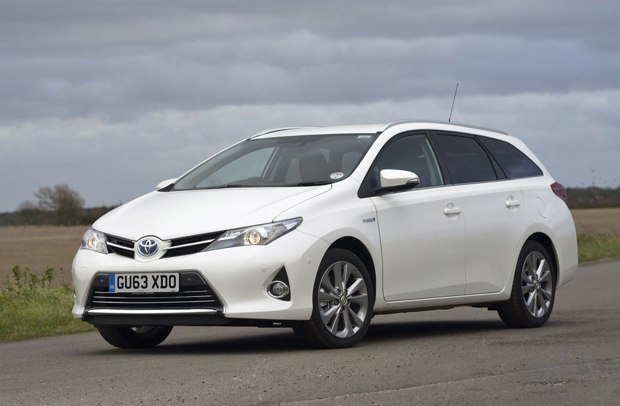

- The hybrid Auris joins our fleet
- Getting to grips with the Auris Hybrid
- Economy in the Auris Hybrid
- CVT - good for economy but not for performance
- Not so Touch & Go
- Select Power mode for economy
- Forget the luggage cover
- Keeping braking to a minimum
- Silence is golden
- Auris alarm bells
- Parking made easy!
- The final Auris reckoning
The hybrid Auris joins our fleet
The latest arrival to the honestjohn.co.uk fleet is the Toyota Auris Sports Touring and we've gone for the hybrid system.

Date: 6 January 2014 | Current mileage: 612 miles | Claimed economy: 70.6mpg | Actual economy: 45.2mpg
It's the start of a new year and for me the start of six months with a new car following the departure of the Skoda Rapid I was driving previously. A car that I was full of praise for. In its place is a spotless (as I write this) and shiny white Toyota Auris Touring Sports. The name is a bit of a mouthful, why they couldn't stick with just estate is a mystery to me, but essentially it's the more practical version of the latest Auris.
We've gone for the hybrid version - it's the second hybrid on our fleet after the Lexus GS450h - but while it's part of the same Toyota family, the Auris has a very different hybrid system. While the Lexus has a 3.5-litre V6 petrol engine, the Auris Touring Sports has a more sensible 1.8-litre VVT-i combined with an electric motor. It's identical to the set-up in the Prius and produces 136PS in total.
This runs through a CVT automatic gearbox - a traditional transmission for hybrid cars. The CVT means the engine will always run at optimum revs for, benefiting fuel economy. It's no ball of fire but this is a car that's focussed on efficency. It can be driven in Eco mode, or if you need a little extra poke, in Power mode. There's also EV mode - useful if you're leaving the house early (which I often am) and don't want to wake everyone up. However this is limited to low speeds before the engine cuts back in.
![]()
According to the official Toyota figures, our Excel version of the Auris Touring Sports can average 70.6mpg with CO2 of just 92g/km. That of course means zero annual VED but it's no longer low enough to qualify for a free pass to the London congestion charge as the limit was last year lowered to 75g/km.
Cleverly the batteries for the electric motor are placed under the rear seats, so weight distribution is perfect for and this also this avoids any encroachment into the load space. And that's good news for me with all the equipment I have to carry around. There's a huge amount of space, especially with the rear seats folded down and according to Toyota it’s an impressive 1,658 litres of space. For me, adding all my photographic kit I drag around the country, its pretty much ideal.
Its up against some pretty stiff competition though such as the Ford Focus Estate and Volkswagen Golf Estate, not to mention the likes of the Hyundai i30 Tourer. So what sets this aside from its competitors? Well that's what I'll be finding out in the coming months.
One thing I already know is that Toyota is well known for its reliability and low servicing costs so this car should help that reputation along nicely as it has less less moving parts to wear being a hybrid. The on the road price is £23,245, which is a little more than its rivals in this spec, but I’ll go into this in more detail in the next update.
Getting to grips with the Auris Hybrid
After 1000 miles we're getting to grips with the Auris Hybrid but for Matt it's a big change from his usual diesel choice.

Date: 20 January 2014 | Current mileage: 1220 miles | Claimed economy: 70.6mpg | Actual economy: 47.7 mpg
After a month with the Auris Touring Sports I'm starting to get to grips with having a hybrid rather than an estate - which would have traditionally been my default choice for a working car. It's a good looking estate. I think it's quite sporty for a Toyota, compared to say the Avensis, helped by daytime running lights, privacy glass and 17-inch alloys.
On the inside it's really what you would expect from Toyota. The driving position is great and everything is laid out well. The dash does seem very straight and high but it's softened with great curved doors and sloping door lines. It's a mixed affair of materials from leather and cloth seats to a mix of grained plastics on the trim. In fact it's a very comfortable place to be. True it's not absolutely premium but it's certainly not bargain cheap. In the back, the comfort continues with generous legroom and a second charging point, which is ideal for the children's iPods.
Out on the road the Auris Hybrid isn't quite as sporty as it looks. Having not lived with a hybrid before, it does take a little while to adjust. Most notable is the lack of recognisable gears as the Auris has a CVT gearbox. That means it's like having one continuous gear when you accelerate but the result is a strange droning sound, not dissimilar to being a passenger in a car with someone who accelerates but doesn't change up to the next gear and just remains at 70 mph in 3rd.

The gearbox has the usual drive, neutral, reverse and park modes but also one labelled B. This creates engine braking, so rather than allowing the car to coast when you come off the accelerator, it uses engine braking to slow you down, plus this recuperates more energy.
So where, does this all get you? Well, the cars trump card is emissions of 83g/km CO2. That's sadly not low enough to quality for free entry into the London congestion charge any more, but it does mean free VED. I wouldn't be surprised if the but off for free VED is lowered in the coming year from its current 100g/km limit. So having a car well below that is reassuring.
The car has three driving modes and I'm looking forward to seeing how economical this car can be. Strangely for a car that's designed for economy there's is a PWR button. Pressing it does indeed make a marked difference in performance. However, what this does to economy remains to be seen.
The central display has quite extensive information on your economy and already I’m changing my driving habits to get the most out of the car, how much I’ll report on in my next update.
Economy in the Auris Hybrid
While Matt is impressed with the interior quality and design of the Auris he's not so enamored by the fuel economy.

Date: 3 February 2014 | Current mileage: 2745 | Claimed economy: 70.6mpg | Actual economy: 48.0mpg
So far I’ve managed to clock up 3000 miles in the Auris and I have to say I’m really liking it. Pretty much everything that you do to engage with the car happens effortlessly even down to the way the indicators click in and out of place and the heating controls. True there are thrills, but it's all simple and every little thing just nicely.
This may sound strange but even the layout of the interior is intuitive. Some cars try to do things a little differently but not the Auris. Everything is solid and works well, the windows slide down quicker than most and the air conditioning seems incredibly quick to warm up or cool down. Even the screen defrosts in the morning quicker than any other car I’ve driven.
The buttons on the steering wheel are very simply laid out and easy to navigate while the cruise control is the simplest I’ve tried. Simply put, there are few thrills, but every single basic switch or button just seems to work better in the Auris.
However its crowning glory comes when you press the heated seat button. There are high or low settings but to be honest low is enough as the high setting is unbelievably hot. Don’t take that as a complaint - it's fantastic. However you’d never need it this hot unless you have an early morning start in the depths of winter in the North Pole.
Features aside, the fact the Auris is a hybrid means economy is a crucial factor. Toyota claim the Auris Hybrid returns a very healthy 70.6mpg, however I must say this seems incredibly ambitious considering the car itself is saying 52mpg on the dash and my own figures give an average of slightly less at 48mpg.

Instruments show when the electric motor is working but economy is still poor in the Auris
It's very hard to pinpoint what exactly is going on here, for a start the fuel tank seems relatively small taking only £50 to fully brim the car, so refuelling seems more frequent compared to a diesel like the Skoda Rapid I ran previously. That said the Auris has a very good central display which shows when its running in EV mode and when the petrol engine cuts in.
It also displays past and present figures and this is where its a bit of a mixed bag. It comes into its own in town where the electric motor seems to cut in more often at lower speeds, leaving motorway driving and cruising around the 40 - 50mpg per journey mark.
My highest recorded economy on a journey was a quick trip in town to the supermarket giving a return of 81mpg, however I also did this journey first thing in the morning when the car was cold and the exact same journey gave me a measly 28mpg.
That temperature clearly affects the performance of the car, just as it would with any, but being a hybrid the differences are vast. There's no getting past its fantastic CO2 emissions but so far I’m not hugely impressed with the economy it's giving.
CVT - good for economy but not for performance
A few long journeys in the Auris Touring Sports have seen Matt utilising the impressive boot capacity but the CVT gearbox hasn't found equal favour.
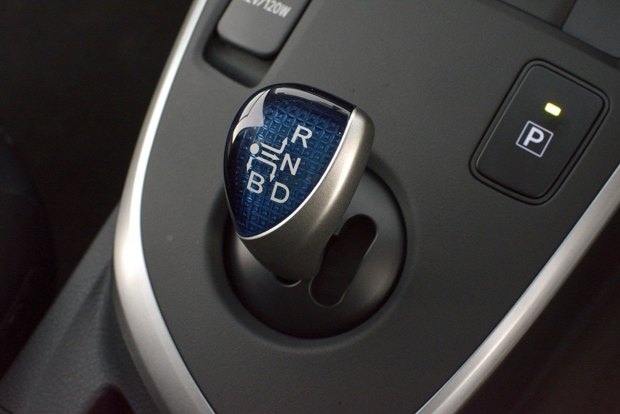
Date: 17 February 2014 | Current mileage: 4016 miles | Claimed economy: 70.6mpg | Actual economy: 47.6mpg
Like the Lexus GS450h which we have on the Our Cars fleet, our Auris Hybrid comes with a CVT gearbox. In theory these are good for economy as they let the engine run at its most efficient revs. But in practice they're not always pleasant to use.
That's certainly the case in the Auris. Push the car hard and it makes an incredible whining sound as if you're already at 8,000rpm and needing to change gear. And the noise doesn't diminish. It doesn't seem particularly economical and this is backed up by the charge/power meter. Accelerate hard and the needle immediately turns orange and swings to the power zone.
It might be a deliberate ploy to slow you down or it's more the nature of how a CVT gearbox works. Either way it discourages acceleration and as a result does a good job of making you drive more economically by default.
Where the Auris Touring Sports has impressed me is with its space. It has an enormous boot while folding down the rear seats boost this to a cavernous space. In fact it is a whopping 1650 litres while the standard boot holds 530 litres. That stands up much better than a Ford Focus Estate which holds 470 litres. A Golf Estate is slightly larger at 605 litres but overall has slightly less capacity with 1620 litres.

So why pick the Toyota over rivals such as Ford or Volkswagen? Well what has really impressed me is its solid nature. There are few thrills and nothing that especially stands out, but the Auris does everything so well. Everything is exactly as you’d expect. It's hard to pinpoint one thing as outstanding but it's very much a vehicle where you don't need an instruction manual - everything is intuitive.
In my last update I also touched on the heated seats and how good they are, but after doing a couple of 400 mile journeys over the last week, it’s the seats themselves that stand out. They are incredibly comfortable - it's one of those things that you only notice over a period of time.
After more than 4000 miles I've not experienced a single niggle or uncomfortable point with the Auris. True I'm not not a huge fan of the CVT gearbox but it does make it a very easy car to drive and relaxing as long as you don't put your foot down too hard. I can see why they call it a Tourer, but I'm not too sure about the Sports bit.
Not so Touch & Go
Of all the various multimedia and infotainment system around from various makes, the Toyota Touch & Go makes a good case for itself as one of the easiest to use.
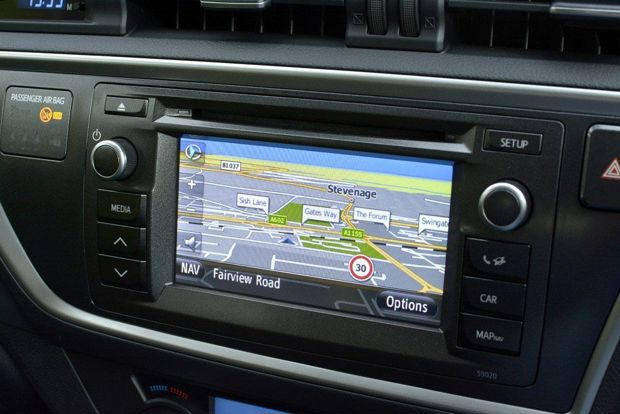
Date: 3 March 2014 | Current mileage: 5065 miles | Claimed economy: 70.6mpg | Actual economy: 50.6mpg
Infotainment, navigation, touchscreen or just 'the radio', whatever you call the multimedia system in your car, there's a huge variety across different makes and models. Toyota call its system Touch & Go which would imply that it's pretty easy to use - you just touch and go.
First off I have to say that like many other things on the Auris, the system works and works extremely well without being flashy. With this system, which can be fully controlled from the steering wheel, you have the ability to be guided by the sat nav, listen to music bluetoothed straight from your phone and make a phone call. All at the same time and without any sort of delay or one of the systems failing or locking up.
The sat nav is the best I've ever used. It's simple to use, never gets it wrong and is easy to programme straight off the bat without any instructions. The voice instructions are also clear with plenty of early guidance before junctions. It also redirects immediately if you miss a turning and most importantly it's consistently accurate.

There are no thrills or gimmicks, it just does exactly what it says it can do every time. It's actually more than just 'touch and go'. It has plenty of neat little tricks up its sleeve - connecting your phone is very simple and immediate via Bluetooth which has never failed while thumbing through your iTunes collection is easy and all from a hands free position which is very quick.
There is also text messaging which can be done but only when you’re stationary, which to be fair seems a little pointless as it’s easier to use your phone normally at this point. There is online connectivity, which you can use as long as your phone has a data connection. I’ve used this a couple of times and it works perfectly when I’ve needed to find a Costa. Its not a necessity in a car but works perfectly when trying to find an obscure location.
Aside from the Touch & Go system, over the past two weeks I've further warmed to the hybrid system. I still can't quite get the economy where I would like it to be although I know that by changing my driving I can improve on this. Interestingly Toyota offers courses on driving economically which is something I will look into in order to improve the economy closer to its reputed 70mpg.
At the moment it stands at 50.6mpg, which is adequate. Strangely I have just done a test involving the difference between the Power mode and the Eco mode, but more on that next week when I have full figures,
Select Power mode for economy
The Auris Hybrid comes with both 'eco' modes and 'power' modes. So do they actually make a difference to real world fuel economy?
Date: 17 March 2014 | Current mileage: 5944 miles | Claimed economy: 70.6mpg | Actual economy: 51.6mpg
Recently I've been testing our Auris Touring Sports in its various driving modes. It’s not the most scientific approach but it has highlighted some interesting points. I have driven exactly the same 75 mile journey at the same time of day in the same weather conditions with the same amount of fuel and weight on board in Eco mode - driving economically using the engine braking - and Power mode, without using the engine brake.
The Power mode makes a significant difference to the performance and is far from a gimmick. The throttle response is greatly improved and acceleration does feel quicker. But this got me thinking as to what it does to economy?
The fact that you have to change from Eco mode to Power would seemingly mean you’re no longer being economical. Or want to be. This may not be Toyota's intention so does it make much of a difference to economy? Well on my 75 mile journey, Power mode gave me economy of 52.8mpg. Driving the exact same journey in Eco mode produced an economy figure of 55.3mpg.
It didn’t feel that different in general driving, but by putting it to the test the figures are pretty close and to be fair there’s not a lot in it. However, there is a significant difference performance wise between Eco and Power mode, far more than the slight difference in economy figures. Personally I would rather drive in Power mode all the time and suffer the very slight loss in economy.
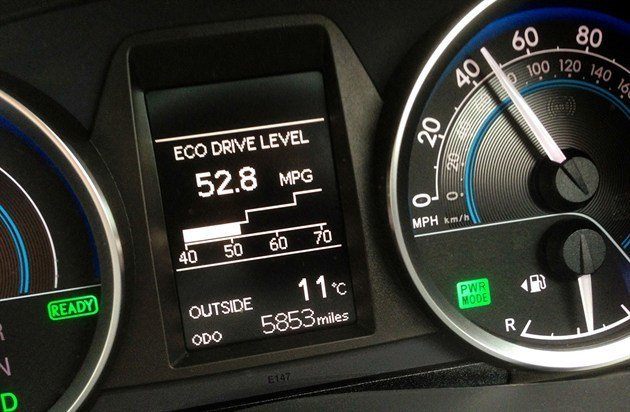
But the twist to all this is that to select Eco or Power mode you have to press the corresponding button. If you press the button again you deselect the mode, meaning you're in the standard setting. Nothing is highlighted in the display leaving you to guess. I presume it defaults to Eco mode and if that is the case what is the point of having the Eco button in the first place?
I haven’t mentioned the third setting, EV mode which allows you to drive just using the electric motor. This is restricted to low speeds and only if there is enough charge in the battery, but when driving to the shops you do feel that you’ve won the eco war if you can get there and back without using any petrol.
However, reading the manual it clearly states that using EV mode for prolonged periods is also very un-economical? I can only assume that this is due to having to use up more fuel in the motor to recharge the batteries than you would by just using the motor in the first place to drive in Eco/Power mode.
So my next test is to drive in Power mode and use the engine brake and see what happens on the same 75 mile journey, I’ll keep you posted on the next update.
Forget the luggage cover
The cavernous boot of the Auris Touring Sports is proving useful for all Matt's camera equipment but the annoying luggage cover is proving less popular.
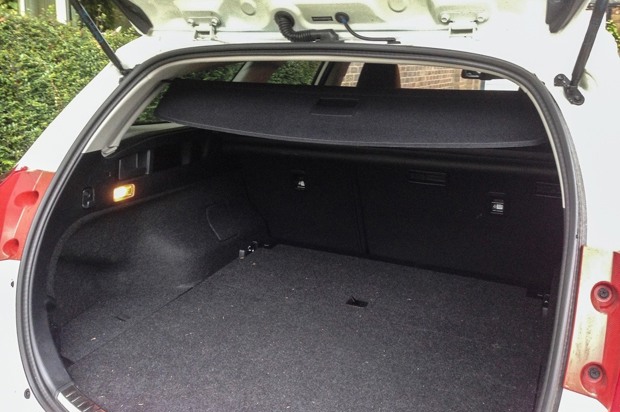
Date: 2 April 2014 | Current mileage: 6740 miles | Claimed economy: 70.6mpg | Actual economy: 51.5mpg
After four months with the Auris there is something that I find incredibly annoying. While the boot is absolutely cavernous, especially with the rear seats folded, the design of the retractable boot cover seems to always catch me out. And seeing as how I always seem to have a boot full of cameras and equipment, it's a regular bugbear.
To fold the rear sears requires minimum effort. Either side of the boot is a lever similar to the inside door levers - a quick pull and the split fold seats simply drop to make the boot enormous. Simplicity itself, however you then have the problem of the retractable boot cover which is clicked into place either side.
This is where the process, although simple enough for me, could be a lot harder for others as you have to physically climb in at an awkward angle in order to pull the cover out if you need the full open space. It destroys the simplicity of the way the seats fold down by utilising pretty much every muscle in my back while I curse trying to remove it. It's a shame as this could surely be designed into the process?
On the subject of the cover itself, it can be pulled into place to cover objects in the boot or you can simply slide it up the rear pillar and click it into a second position to move it out of the way if you quickly want to grab something. This is where I have repeatedly cursed myself because it's all so easy to forget you've done this only to find when you jump back into the driver's seat that the cover now completely obstructs the whole rear window. So you have to jump back out and repeat the whole process.
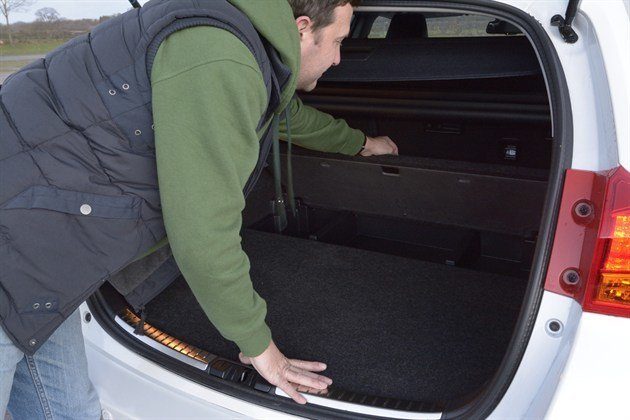
Useful underfloor storage areas make the Auris incredibly versatile
It doesn't sound much but after the 50th time it can be very annoying. To be fair, I’m not certain that’s entirely the cars fault. The obstructed view might be but forgetting to slide it back is all mine. In the cars defence, all isn't lost because even if you can’t be bothered to get out again, as soon as you place the car in reverse the rear camera displays on the central screen.
One good thing about the large boot of the Auris Touring Sports is the clever underfloor storage. This is more than just a space where the spare wheel would go. In the Auris it includes useful separate compartments behind the rear seats. which are ideal for small or delicate objects, or things that you don't want on display. I've taken to keeping handy things like a first aid kit, tow rope and de-icer in there.
In my last report I mentioned that I would try the same 75 mile journey as I have previously tested but driving in power mode albeit as economically as possible and using the engine brake. The result was a 54.6mpg economy figure, which is pretty much identical to driving in eco mode at 55mpg.
There isn’t enough difference between the figures to justify the separate modes but there is a significant difference in performance between them that makes me question why? There are a few anomalies but I have to point out that they are minor points as this car has very low emissions, in fact at 92g/km it's the lowest of any estate car of this size.
Keeping braking to a minimum
The Auris has a useful engine braking mode built into the gearbox and Matt has been finding it useful for improving economy.
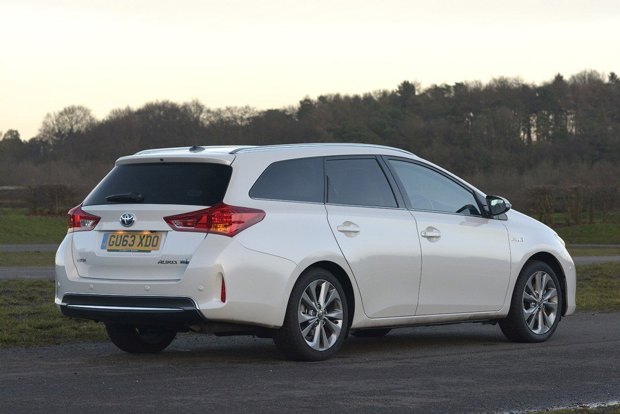
Date: 23 April 2014 | Current mileage: 7028 | Claimed economy: 70.6mpg | Actual economy: 51.9mpg
The past few weeks with the Auris have seen economy ever so slowly creeping up to the 54mpg mark, which is still quite a way off the official figure of more than 70mpg. I've been driving in the Power mode as there doesn't seem to be much noticeable difference in economy compared to driving in Eco mode.
It is clear that in order to massively improve my economy I need to change my driving habits. This includes reducing speed, steadily accelerating and avoiding heavy braking. In fact, keeping braking to a minimum if possible. There are many factors that also contribute such as the weather, carrying heavy loads, hills and inclines and tyre choice.
Sometimes you can't control all these factors but what about ones you can affect? In the Auris there is a little nifty trick that helps in more than one way. On the gearbox is a B setting. This isn't a standard brake but an engine brake which effectively places the car in a higher gear using the engine revs to slow you down. This aids economy by reinvesting some of that kinetic energy back into the battery charge.
It also saves wear and tear on your brake pads which helps reduce running costs. Initially, I completely ignored the engine brake, but I have to say it has completely changed the way I drive. I now use it at every possible moment. That’s partly because it clearly does improve econmy and because it’s so easy to use.
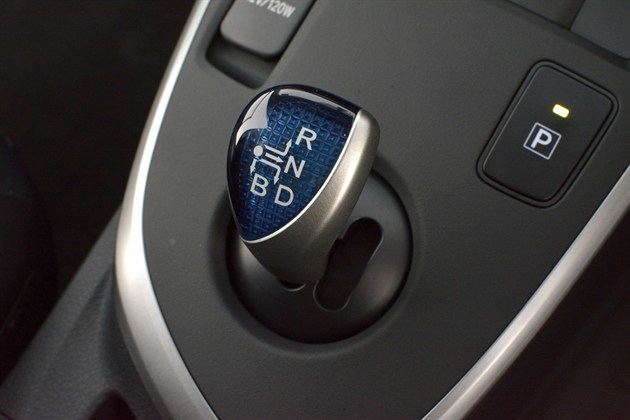
Matt has been using the B setting on the Auris gearbox pretty much continuously
By using the engine brake you'll immediately notice deceleration, but not as heavy as if you were pressing the brake pedal. Its effectiveness changes in different given situations, most apparent is at higher speeds, for example pulling off a motorway, you’ll notice the breaking is more apparent as is the higher drone of the engine note.
I have found myself braking much earlier and anticipating a braking moment far earlier than I normally would, which in turn is definitely adding to my economy. Whether that was the intention of Toyota is a good question, but it does subconsciously make you drive more economically and more safely.
However as with everything there is always a downside. Not that it's the car's fault. But the fact that UK roads are so congested and most people to close to each other with braking distances non existent, means the engine brake doesn't notify people behind that you are slowing down. There are no brake lights using the engine brake. I can’t tell you how many times i've noticed bulging eyeballs from late brakers in my rearview mirror.
Silence is golden
When the Auris is running purely in electric mode it creates no sound - apart from the tyres on the road - but this does present a problem for pedestrians.

Date: 14 May 2014 | Current mileage: 9648 miles | Claimed economy: 70.6mpg | Actual economy: 53.2mpg
Since my last update I've managed to cover a fair few miles in the Auris and to be perfectly honest there are no niggles to mention. In fact quite the opposite. The car just does everything you need and everything it does, it does solidly.
That said I have had just one slight problem with connecting my iPhone via Bluetooth. It is supposed to connect automatically but sometimes decides not to immediately. It has done this a number of times, but it has never actually failed to connect - for some reason it occassionally takes a few attempts.
But that's it. Nearly 10,000 miles of hassle free and effortless motoring without any problems whatsoever. In fact I gave the car a good clean up the other day and it’s sitting on the driveway exactly as the day it was delivered. The fuel economy is also starting to creep up. It has taken a while to get used to driving a hybrid, but I have to say it has changed the way I drive and I'm now far more relaxed behind the wheel, a side effect of driving more economically.
It's down to using the engine braking plus anticipating traffic more, which makes you increasingly aware of your speed and, more importantly, means you leave a bigger gap between yourself and the car in front. I'm still not seeing a huge difference between the Eco and Power modes in terms of fuel economy, but there is a big difference in performance when pressing the Power button.

I have noticed that I do get a few strange looks, especially in supermarket car parks, when the car drops into EV mode, but that’s to be expected as it makes absolutely no noise whatsoever other than the sound of tyres. That is one issue of the EV mode. Pedestrians cannot always hear you before you nearly drive into their shopping trolley. Worse for me was reversing off the driveway and nearly taking out a chap on his way to work.
Admittedly, my drive does have a blind spot with hedges onto the main road, so not only am I more aware that people cannot hear me, but I end up going through a series of checks before driving away. Before I even get in the car I now have to walk to the end of the drive and look down the road to see if anyone is on the pavement before reversing.
That’s one of the downsides of the reversing camera, you can see the look of surprise on peoples faces as they realise they just had a close shave. But it does highlight a problem that the silence of an electric car means people aren't always aware there's a vehicle nearby.
Again the Auris Hybrid changes the way you drive and I guess just makes you even more aware of your surroundings. Of course the downside is that none of us are perfect. I hate to say it, but from a safety point of view, this is exactly the kind of vehicle that should announce its reversing.
Auris alarm bells
Thanks to its silent electric power, it's all too easy to leave the Auris hybrid running when stationary with the keys in it.
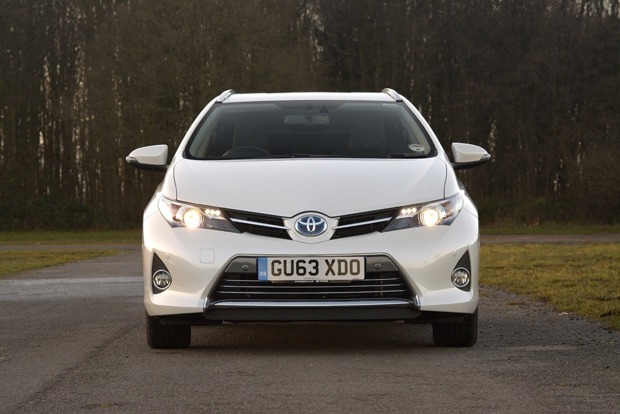
Date: 28 May 2014 | Current mileage: 10,935 | Claimed economy: 70.6mpg | Actual economy: 53.4mpg
The latest development with the Auris again involves the sound. Or rather lack of sound that the car makes. However this time it's more of a security issue more than anything else. As mentioned before, I’ve been driving using the engine brake as much as possible which normally means the batteries are very well charged.
At the end of my journeys, driving along my road at 20mph the car inevitably always drops into EV mode and there it remains on the driveway until I turn the car off. But this is where the problem lies. Twice this week, without me realising it I’ve simply left the car running on the driveway unlocked and that’s down to the fact that its not making any noise whatsoever. How is this possible?
Well, its because I’ve finished my work, unloaded my camera equipment but then forgotten to lock the car. That's completely my fault, but what I hadn't realised is that the keys were still in the Auris and the car was still 'running'. Because of its nature in EV mode, there is no indication that its effectively sitting there silently idling.
To check if there’s anything that Toyota has done to remedy this, I puposefully left the car running and then walked away with the key in my pocket. Sure enough, a very audible alarm alerts you to the fact that you've left the car and it's still running - only without the key. Once again Toyota has thought about this, but there still lies the problem of leaving the car and the keys in it like I did.

An alarm is about to sound. And annoy all the neighbours.
I know you can't cater for absent minded individuals like myself but it does highlight another problem in that we rely on sound sometimes just to let us know that the car is actually switched off. It's a situation which would never occur on a standard car.
It also raises the question of security. What would happen if somebody simply just got into the car and drove off in it? So to remedy my own forgetfulness, I’ve now set the wing mirrors to fold in when I turn off the car. That way I know that the car is locked and turned off visually.
However, a simpler approach would be to actually have a good old-fashioned key that actually starts and stops the car. That way it's impossible to leave the car running, but that would ruin the simplicity of just getting in and pressing the button to start. It just means not only do I now check the pavement for pedestrians but I also check the wing mirrors and that’s even before I get in and drive!
Parking made easy!
Our Auris Touring Sports is fitted with a self park system and Matt has been giving it a go. Is it more than just a gimmick?

Date: 11 June 2014 | Current mileage: 12,677 | Claimed economy: 70.6mpg | Actual economy: 54.1mpg
Something very handy that I hadn't noticed before with our Auris is that it has a proximity sensor in the key. If you walk up to the boot with the key in your hand and simply go to open the boot, it will unlock itself before you get there. It saves putting everything down and fumbling around for the keys and unlocking the car.
This also goes for the doors, which again makes the whole process of unlocking the car much easier than with a traditional key fob. I have to say the Auris Hybrid is effortless in this respect, the whole process of unlocking and starting the car is a breeze and it is something I have got used to very quickly.
In fact, the Auris goes a step further as our car is fitted with a parallel parking assist button and parking sensors all round. Now, for me this is pretty much a step too far, but I have to say it's a very good system indeed. As with everything else on the Auris Touring Sports, it's simple and it just works - there’s no flair involved. It simply does what it says on the tin.
It's not something I’ve used up till now. I'm a pretty capable parker but recently I’ve decided to let the car take over and give it a go. The process is very simple, you spot a space to park into and simply press the park assist button. From here on, the display guides you forwards until it signals you to stop and apply reverse gear.

Parking made simple. The Auris will guide you into a space so no more parking scrapes.
Then it is just a case of pedal control as the car effortlessly steers itself into the space and then then requests you change the car back into drive for the precision park. It's very simple and I’ve tried this at least ten times now without the car ever getting it wrong.
In fact I doubt the system can get it wrong because the sensors will detect the space and if it is to small or the angle too acute, it won't ask you to select reverse to start the parking process. If you aren't confident enough or are unsure if the space you intend to park in is big enough, you’ll probably go with the parking system decision every time.
I’ve never used the park assist before but mainly because I’ve never really found many situations where I've needed it. Having said that, it has massive potential if you live in a crowded street or park in congested areas.
It is one of those options that swings either way depending on whether you feel it's something you really need. I would say though that the visibility in the Auris Touring Sports is very good and coupled with the rear facing camera, it's an easy car to park. The system just makes it even easier.
The final Auris reckoning
After six months Matt looks back on his time with the Auris. A car that's really won him over.

Date: 25 June 2014 | Current mileage: 12,986 | Claimed economy: 70.6mpg | Actual economy: 53.8mpg
So my six months with the Auris Hybrid Touring Sports have come to an end and I have to say, I've been really quite surprised by the Toyota. I think the first and most important question to answer, considering it's a hybrid, is what has fuel economy been like?
Well, over the last 12,000 miles the cars trip computer has said averaged 53.2mpg, however I have also been recording my own real world figures. There is not much different actually - my calculations reveal an economy figure of 50.4mpg. However this is a far cry from the Toyota official figure of more than 70mpg.
That said I don't doubt for one minute that this economy cannot be achieved given the correct set of conditions. The car does collect journey data and my best journey in town wasn't very long, in fact just over 4.5 miles, but it did it at an average of 81mpg.
I would estimate that 75 per cent of my journeys consist of motorway miles and as mentioned in previous updates I'm certain this cars economy shines in urban driving where the EV mode cuts in far more often. Most importantly, the hybrid cuts CO2 emissions dramatically. In fact, the Auris Hybrid is one of the lowest emission cars on sale and considering its size that’s no easy engineering feat.

The Auris Touring Sports has proved the ideal vehicle for snapper Matt
But economy and CO2 aside, the Auris Touring Sports has really performed well. I haven't had any niggles or complaints and there’s nothing in the cabin that’s gone awry. Given that after a while, especially 12,000 miles, you’d expect a rattle or a creak, but this being a Toyota, there’s been not so much as a peep.
With clean interior and exterior, the Auris looks as good as the day it was delivered. I’m really impressed with how solid the car is. Most importantly is how the Auris Hybrid has changed the way I drive. I'm now driving more economically, concentrating more on anticipation and braking ahead of any potential traffic.
In terms of size, it's big inside. In fact, within its class it's one of the biggest and very easy to load in terms of access to the boot and ease of reclining seats. Considering my work this is probably my ideal car in terms of size as I can fit all my equipment in. Would I buy one? The answer is definitely yes.
My main reason is that it ticks all the boxes that I look for in a car. But the main box is reliability. That’s the Auris hybrid's secret. Everything works well and keeps on working. It doesn't have much flair, but it just does everything very well. It will be very hard stepping into my next car.
